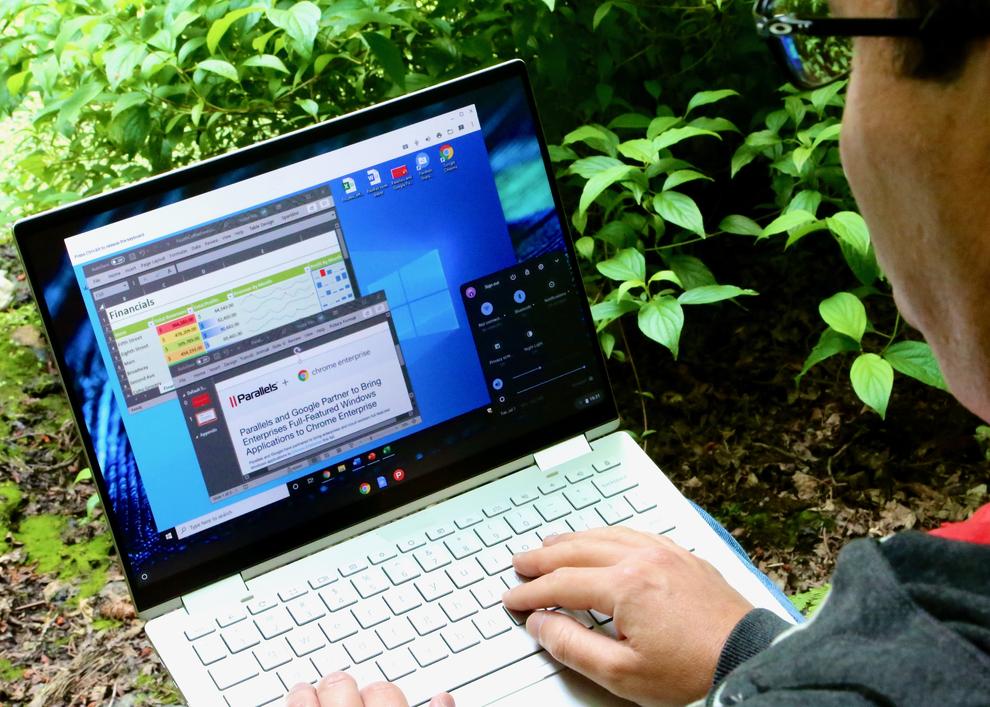New software program runs Windows directly on Chromebooks
- 21 October, 2020 15:00

Shared folders and files in Chrome OS
Parallels claims its newly-launched Desktop for Chromebook Enterprise is the world’s first software that runs Windows directly on enterprise Chromebooks.
The software enables full-featured Windows apps, including Microsoft Office and proprietary apps, even when there is no Internet connection. It is integrated with Chrome OS and Google Admin console, and does not require VDI infrastructure, making it easy for IT departments to securely set up and deploy.
“Parallels Desktop for Chromebook Enterprise incorporates more than 22 years of Parallels’ experience innovating software that makes it simple for people to seamlessly run multiple operating systems and applications on any device, to be more productive,” Parallels senior vice-president of engineering and support, Nick Dobrovolskiy, said
“In addition to simultaneously running Windows and its full featured apps alongside Chrome OS apps directly on a Chromebook, Parallels Desktop integrates a variety of useful features: Copy and paste text and graphics between Windows 10 and Chrome OS; frustration-free printing from Windows apps via shared Chrome OS printers or from printers that are only available for Windows 10; and the option to save Windows files locally on a Chromebook, in the Cloud, or both.”
“Chrome OS is increasingly being chosen by modern enterprises, either for remote work, hybrid, or in the office,” Google vice-president of Chrome OS, John Solomon, said. “We are thrilled to partner with
Parallels to bring legacy and full-featured Windows applications support, through Parallels Desktop for Chromebook Enterprise, to help businesses easily transition to Cloud-first devices and workflows.”
Features of the new program include:
- Run multiple full-featured Windows apps and Chrome OS apps simultaneously – Run Microsoft
- Office and other full-featured Windows apps directly on an enterprise Chromebook. Add
- chart trendlines in Excel, captions and citations in Word, and custom fonts or headers and footers in PowerPoint – capabilities that are not available in other versions of Microsoft Office – while simultaneously working with Chrome OS apps. No need to reboot or to use unstable emulators.
- Install and run any business-approved full-featured Windows application on a Chromebook and run them even without an Internet connection or when you have a low-bandwidth connection.
 Credit: Parallels
Credit: Parallels Productivity enhancers and seamless integrations include:
- Share Clipboard – Copy and paste text and graphics between Windows and Chrome OS in both directions, from Windows to Chrome OS, and from Chrome OS to Windows.
- Shared User Profile – Windows user folders (desktop, documents, and downloads) are redirected to the Windows files section in Chrome OS to ensure access to files by Chrome OS applications without creating duplicates. Additionally, this allows Chrome OS to access these files when Windows is not running.
- Share custom folders – Share any Chrome OS folder with Windows, including cloud storage folders such as Google Drive or OneDrive, and use it to save Windows application files.
- Dynamic screen resolution – Simply click and drag the corner or edge of the Windows 10 window to easily change the screen resolution of Windows.
- Full screen support of Windows 10 – Set Windows 10 to use the full screen of the Chromebook by selecting the Maximise button in the window’s upper-right corner. Put Windows on a separate Chrome OS virtual Desk and switch from Chrome OS to Windows and back again with a simple swipe.
- Open Windows web links where you prefer – Windows 10 can be set to open Web links in Chrome OS or to use a Windows browser of choice such as Chrome, Microsoft Edge, Internet Explorer, Firefox, Brave and Opera.
- Associate Windows applications to open files on Chrome OS – Windows applications are fully integrated in the Chrome OS “Open With” interface. Assign a Windows application as a default application for certain types of files or to open a file in Windows.
Virtualisation essentials include:
- Suspend and resume Windows – Easily suspend and resume Windows to instantly get back to work.
- Use Chromebook mouse, touch, and keyboard to work with Windows apps.
- Mouse cursor synchronisation – Simply move and use your mouse cursor between Chrome OS to Windows and back again; the cursor automatically transforms aesthetically to the look and feel of each operating system (OS).
- Scroll and zoom – Windows applications may use a touchpad, mouse, or touchscreen to scroll and zoom.
- Sound – Play Windows apps’ sounds. Microphone support is also planned for a future update.
- Disk performance – Parallels’ proprietary virtual disk technology delivers improved performance in comparison with a simple Non-Volatile Memory Express (NVMe) driver.
- Networking – Windows uses your Chrome OS network connection, even if it is a VPN. Settings may also be selected for VPN use in Windows.
System Requirements for the new software: Processor – Intel Core i5 or Intel Core i7; Memory – 16GB: Storage – 128 GB SSD or more.
Preferred devices are:
- HP – HP Elite c1030 Chromebook Enterprise (recommended); HP Pro c640 Chromebook Enterprise
- Google – Google Pixelbook; Google Pixelbook Go
- Acer – Acer Chromebook Spin 713; Acer Chromebook Spin 13
- Dell – Dell Latitude 5300 2-in-1 Chromebook Enterprise; Dell Latitude 5400 Chromebook Enterprise
- Lenovo – Lenovo Yoga C630 Chromebook
- ASUS: – ASUS Chromebook Flip C436FA
Enterprise customers can use their existing Windows licenses and agreement with Microsoft.
Google Admin console: IT administrators can manage Chromebook devices that are covered by Chrome Enterprise or Education Upgrade.
Parallels Desktop for Chromebook Enterprise is now available for AUD $99.99 annually per user. Product details, including a free full-featured one-month trial with five user licenses, are available online.





